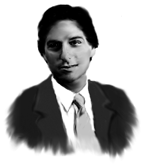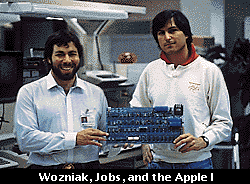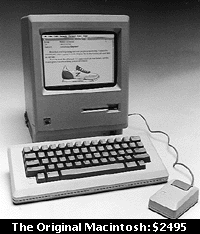
|
|
|
|
|
|

When Jobs was a freshman in high school, William Hewlett
offered him a summer job at the Hewlett-Packard plant. It was there, when Jobs
was 13, that he met the man with whom he would invent "the first ready-made
personal computer"--the 18 year old, college drop-out Steve
Wozniak (Lemelson-MIT). At this time though, Jobs helped Wozniak sell his
"'blue box' an illegal pocket-size telephone attachment that would allow the
user to make free long-distance calls" (Angelelli). Jobs also worked on his
entrepreneurial skills, selling and repairing stereos throughout his high school
career, in addition to his job at the plant.
In 1972, Jobs graduated from high school, and went
to Reed College. After the first semester, he dropped out of the school,
but stayed around the campus, "taking classes in philosophy and immersing
himself in the counterculture" (Angelelli).
In 1974, Jobs started working as a video game designer
for Atari, Inc., "a pioneer in electronic arcade recreation" (Angelelli).
After working for several months and saving his money, he then went to
India with a friend in search of spiritual enlightenment.
 When
he returned, Jobs started attending weekly meetings of Wozniak's Homebrew
Computer Club. While Wozniak was "content with the joy of electronics .
. . . [Jobs] had his eye on marketability of electronic products and persuaded
Wozniak to work with him toward building a personal computer" (Angelelli).
So with Jobs' "passionate belief in bringing computer technology to everyone"
and Wozniak's "engineering talent" they became a team (Lemelson-MIT).
When
he returned, Jobs started attending weekly meetings of Wozniak's Homebrew
Computer Club. While Wozniak was "content with the joy of electronics .
. . . [Jobs] had his eye on marketability of electronic products and persuaded
Wozniak to work with him toward building a personal computer" (Angelelli).
So with Jobs' "passionate belief in bringing computer technology to everyone"
and Wozniak's "engineering talent" they became a team (Lemelson-MIT).

The Apple I lead to the Apple II. The successful
Apple II has been described as "the Volkswagen of computers" (Angelelli).
Jobs "created the sleek design for the Apple II" with its plastic casing
and featuring the Apple logo, "an apple with a missing bite, playing on
the word 'byte,' one of the central units of information in computer languages"
(Notable).

There were three main factors in the Apple II's
success. One reason being it had an open system that allowed for add-ons
like modems. The second was that after 1978 the computer came with a Wozniak
engineered disk drive. Lastly, in the fall of 1979, two Apple devotees
developed a spread sheet program that only ran on Apple Computers. Thus,
in three years, Apple computers had a growth of 700 percent.
But soon IBM had a version of the personal
computer on the market and Apple began struggling to stay on top of the
market. So in 1983, Jobs lured John Scully from Pepsi-Cola to help him
compete, saying "If you come to Apple you can change the world" (Angelelli).
After the failed Apple III and Lisa computers (Apple
III had design flaws and Lisa, though user friendly was too expensive),
Apple introduced the Macintosh. Jobs designed it to compete with the PC,
and on Super Bowl Sunday in 1984, the Macintosh was unveiled with the promise
that "1984 would not be like 1984" (Angelelli). The Macintosh, the first
truly user-friendly computer, with its mouse, icons, and pop-up menus,
was hailed by Jobs as being "not just great . . . but insanely great" (Levy,
27).

The Macintosh was a success, "over 400,000 Macs were sold in the first
year of production," but it did not ease any of the tension at Apple (Making
of). In 1985, Wozniak left and Scully demoted Jobs. Jobs then left
Apple to form his own company. This company, NeXT, has a focus on educational
computing. Though the final product sold poorly, its "workstation concept
with high-level graphics and advanced technology resulted in Jobs receiving
the 1989 Software Publishers Association's Lifetime Achievement Award"
(Notable ).
In 1991, Jobs married Laurene Powell and they now have two
children. Jobs is presently using his prestige and influence which he earned
at Apple to further advance computer technology and provide an alternative to
Microsoft. Jobs feels "Microsoft has not transformed
itself into an agent for improving things or a company that will lead the next
revolution in software development" (Angelelli). Jobs has also become "concerned
because he sees Microsoft competing very fiercely to put a lot of companies
out of business . . .hurting innovation in the computer industry" (Angelelli).
Jobs would rather the public use NeXT, instead of Microsoft.
Angelelli, Lee. Steve Jobs . 7 Dec. 1994. Online. Internet. 14 Jan. 1998. Available http://ei.cs.vt.edu/history/Jobs.html.
The Lemelson-MIT Prize Program: Steve Jobs and Steve Wozniak. Online. Internet. 14 Jan. 1998. Available http://web.mit.edu/invent/www/inventorsI-Q/apple.html.
Levy, Steven. Insanely Great: The Life and Times of Macintosh, The Computer thatChanged Everything.New York: Viking, 1994.
The Making of Silicon Valley A Hundred Year Renaissance.1995 Online. Internet. 16 Jan. 1998. Available http://www.sentius.com/SiliconValley/apple.htmx.
Notable Twentieth-Century Scientists.Ed. Emily J. McMurray. New
York: Gale Research Inc., 1995.